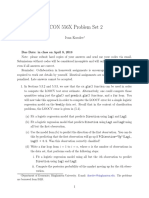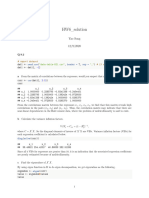Assignment 4
Uploaded by
hsarpong15Assignment 4
Uploaded by
hsarpong15RMI 8300
Assignment 4
Please show your work clearly to get full credit
1. (a) Use the rnorm() function to generate a predictor X of length n = 100, as
well as a noise vector 𝜖 of length n = 100.
(b) Generate a response vector Y of length n = 100 according to the model
c) Use the regsubsets() function to perform best subset selection in order to choose the
best model containing the predictors X, X2,...,X10. What is the best model obtained
according to Cp,BIC,andadjustedR2? Show some plots to provide evidence for your
answer, and report the coefficients of the best model ob-tained. Note you will need to
use the data.frame() function to create a single data set containing both X and Y .
(d) Repeat (c), using forward stepwise selection and also using back-wards stepwise
selection. How does your answer compare to the results in (c)?
(e) Now fit a lasso model to the simulated data, again using X, X2, ...,X10 as
predictors. Use cross-validation to select the optimal value of λ. Create plots of the
cross-validation error as a function of λ. Report the resulting coefficient estimates, and
discuss the results obtained.
2. Use College data set by using library(ISLR).
(a) Split the data set into a training set and a test set.
(b) Fit a linear model using least squares on the training set, and report the test
error obtained.
(c) Fit a ridge regression model on the training set, with λ chosen by cross-
validation. Report the test error obtained.
(d) Fit a lasso model on the training set, with λ chosen by cross-validation. Report
the test error obtained, along with the number of non-zero coefficient estimates.
You might also like
- University of Michigan STATS 500 hw4 F2020No ratings yetUniversity of Michigan STATS 500 hw4 F20202 pages
- Checking, Selecting & Predicting With Gams: Mathematical Sciences, University of Bath, U.KNo ratings yetChecking, Selecting & Predicting With Gams: Mathematical Sciences, University of Bath, U.K21 pages
- WINSEM2024-25_CSE3506_ELA_CH2024250502181_Reference_Material_III_21-12-2024_21NEW3No ratings yetWINSEM2024-25_CSE3506_ELA_CH2024250502181_Reference_Material_III_21-12-2024_21NEW37 pages
- Example Sheet 4 1a. Data - Read - Table ("Salary - TXT", Sep "", Header FALSE)No ratings yetExample Sheet 4 1a. Data - Read - Table ("Salary - TXT", Sep "", Header FALSE)4 pages
- AP Computer Science Principles: Student-Crafted Practice Tests For ExcellenceFrom EverandAP Computer Science Principles: Student-Crafted Practice Tests For ExcellenceNo ratings yet
- Violations of Classical Assumptions: Chapter FourNo ratings yetViolations of Classical Assumptions: Chapter Four38 pages
- Line Drawing Algorithm: Mastering Techniques for Precision Image RenderingFrom EverandLine Drawing Algorithm: Mastering Techniques for Precision Image RenderingNo ratings yet
- Advanced Mathematics Curve Fitting: Prepared byNo ratings yetAdvanced Mathematics Curve Fitting: Prepared by17 pages
- Lecture 12 - Adv. Correlation and Multiple RegressionNo ratings yetLecture 12 - Adv. Correlation and Multiple Regression32 pages
- Regularization and Feature Selection: Big Data For Economic ApplicationsNo ratings yetRegularization and Feature Selection: Big Data For Economic Applications39 pages
- IE 451 Fall 2023-2024 Homework 4 SolutionsNo ratings yetIE 451 Fall 2023-2024 Homework 4 Solutions19 pages
- Linear Regression With LM Function, Diagnostic Plots, Interaction Term, Non-Linear Transformation of The Predictors, Qualitative Predictors100% (1)Linear Regression With LM Function, Diagnostic Plots, Interaction Term, Non-Linear Transformation of The Predictors, Qualitative Predictors15 pages
- 6th Lecture Note 108335647 230518 203102No ratings yet6th Lecture Note 108335647 230518 20310235 pages



























































